VSecM Architecture
 Introduction
Introduction
This section discusses VMware Secrets Manager architecture and building blocks in greater detail: We will cover VMware Secrets Manager’s system design and project structure.
You don’t have to know about these architectural details to use VMware Secrets Manager; however, understanding how VMware Secrets Manager works as a system can prove helpful when you want to extend, augment, or optimize VMware Secrets Manager.
Also, if you want to contribute to the VMware Secrets Manager source code, knowing what happens under the hood will serve you well.
 Components of VMware Secrets Manager
Components of VMware Secrets Manager
VMware Secrets Manager (VSecM), as a system, has the following components.
 SPIRE
SPIRE
SPIRE is not strictly a part of VMware Secrets Manager. However, VMware Secrets Manager uses SPIRE to establish an Identity Control Plane.
SPIRE is what makes communication within VMware Secrets Manager components and workloads possible. It dispatches x.509 SVID Certificates to the required parties to make secure mTLS communication possible.
Check out the official SPIFFE/SPIRE documentation for more information about how SPIRE works internally.
It Is More SPIFFE than SPIRE
Technically, any SPIFFE-compatible Identity Control Plane can be used with VMware Secrets Manager. However, only SPIRE comes as part of the default installation.
 VSecM Safe
VSecM Safe
vsecm-safe stores secrets and dispatches them to workloads.
 VSecM Sidecar
VSecM Sidecar
vsecm-sidecar is a sidecar that facilitates delivering secrets to
workloads.
 VSecM Sentinel
VSecM Sentinel
vsecm-sentinel is a pod you can shell in and do administrative
tasks such as registering secrets for workloads.
Here is a simplified overview of how various actors on a VMware Secrets Manager system interact with each other:
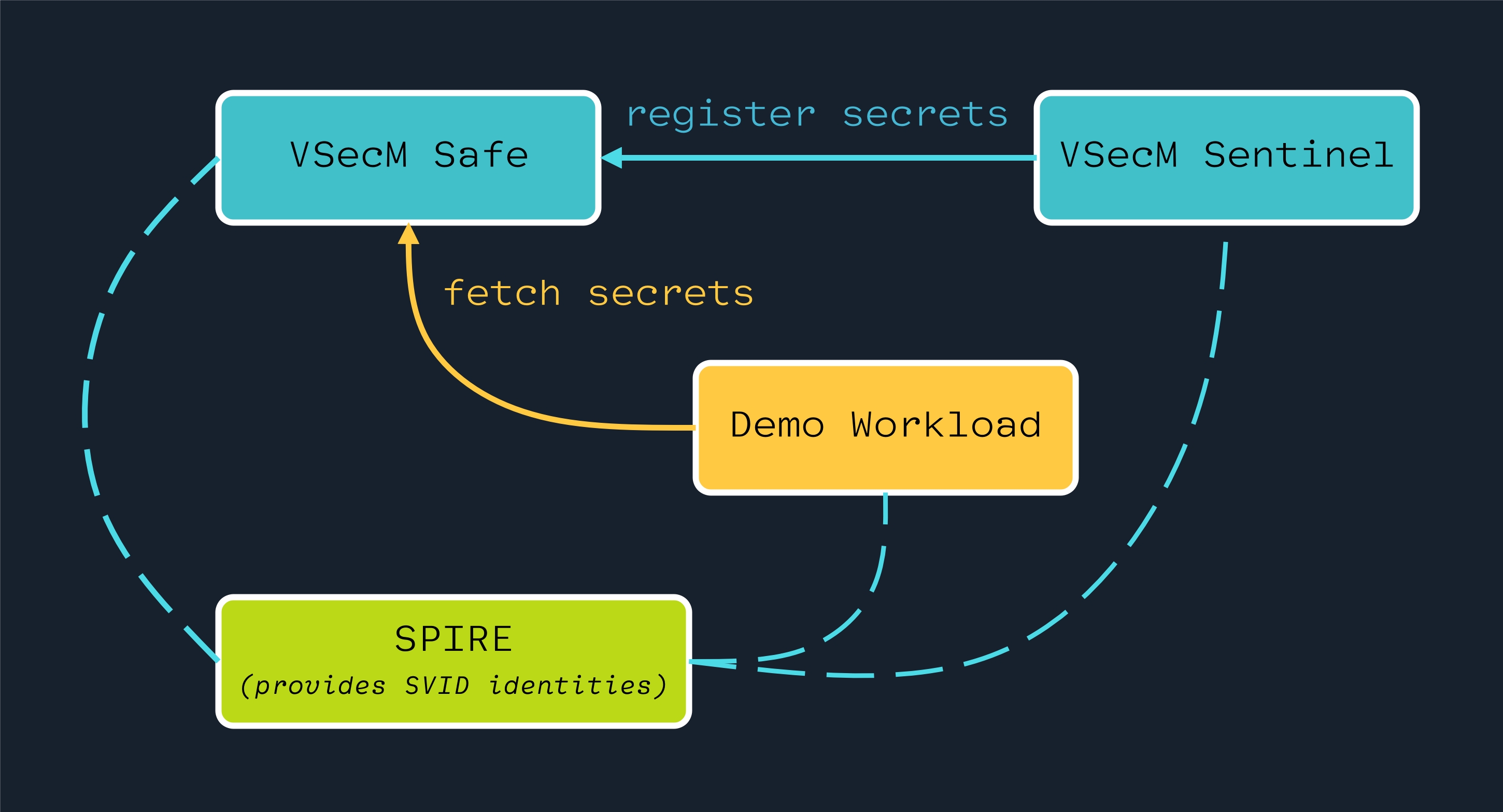
 VSecM Keygen
VSecM Keygen
vsecm-keygen is a utility that generates the root key that
VSecM Safe uses, if manual input mode is set. By default, VSecM Safe
generates the root key automatically; however, you can opt out from this
if you want to control the root key yourself and provide your own key.
You can check out the CLI documentation for more information about how to use VSecM Keygen.
You can also use VSecM Keygen to decrypt secrets that VSecM Safe stores. This will require you to provide the root key that VSecM Safe uses. Again, can check out the CLI documentation for more information.
 VSecM Keystone
VSecM Keystone
vsecm-keystone is a component that leverages VSecM Init Container
behind the scenes.
When the entire VSecM system finishes bootstrapping, and it is ready
for operation, VSecM Keystone will be in a Ready state.
This is useful when you want to configure your orchestrator to wait until VSecM is ready before starting your workloads.
VSecM Keystone is an optional component and it may be disabled if you do not need it.
 VSecM Init Container
VSecM Init Container
vsecm-init-container is a sidecar that you can add to a workload to let
it wait until a secrets is registered for it in VSecM Safe.
This is useful for use cases where you want to make sure that a workload does not initialize without the required secrets.
You can check out the use cases section for more information.
 VSecM Inspector
VSecM Inspector
VSecM Inspector is a sample application that has an ./env executable
at the root of it where you can shell into it and execute ./env to
see the secrets that VSecM Safe injects to it.
This is useful for debugging and testing purposes.
 High-Level Architecture
High-Level Architecture
 Dispatching Identities
Dispatching Identities
SPIRE delivers short-lived X.509 SVIDs to VMware Secrets Manager components and consumer workloads.
VSecM Sidecar periodically talks to VSecM Safe to check if there is a new secret to be updated.
Open the image above in a new tab or window to see it in full size:
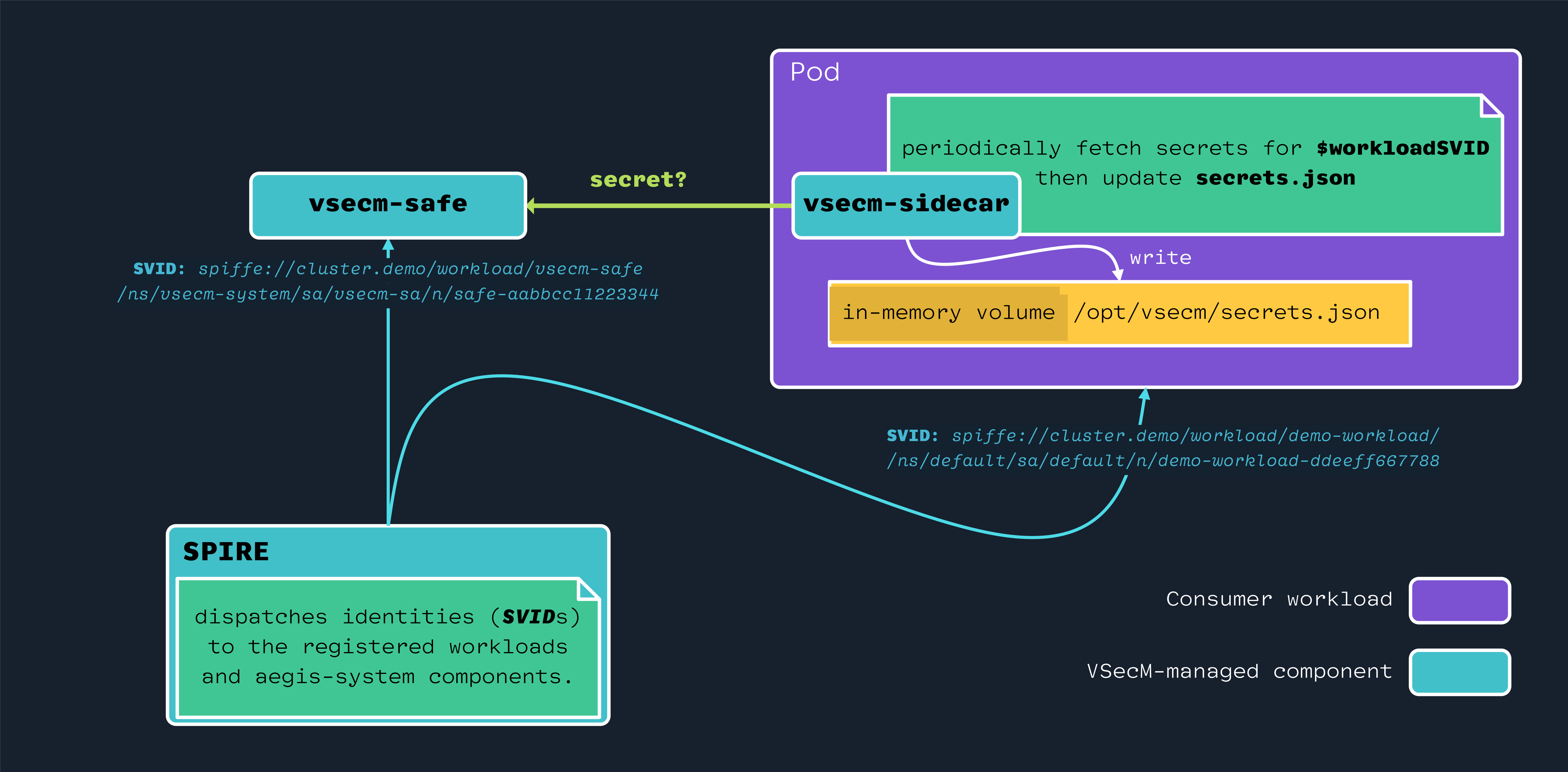
Alternatively, you can use VSecM SDK to retrieve secrets from VSecM Safe programmatically:
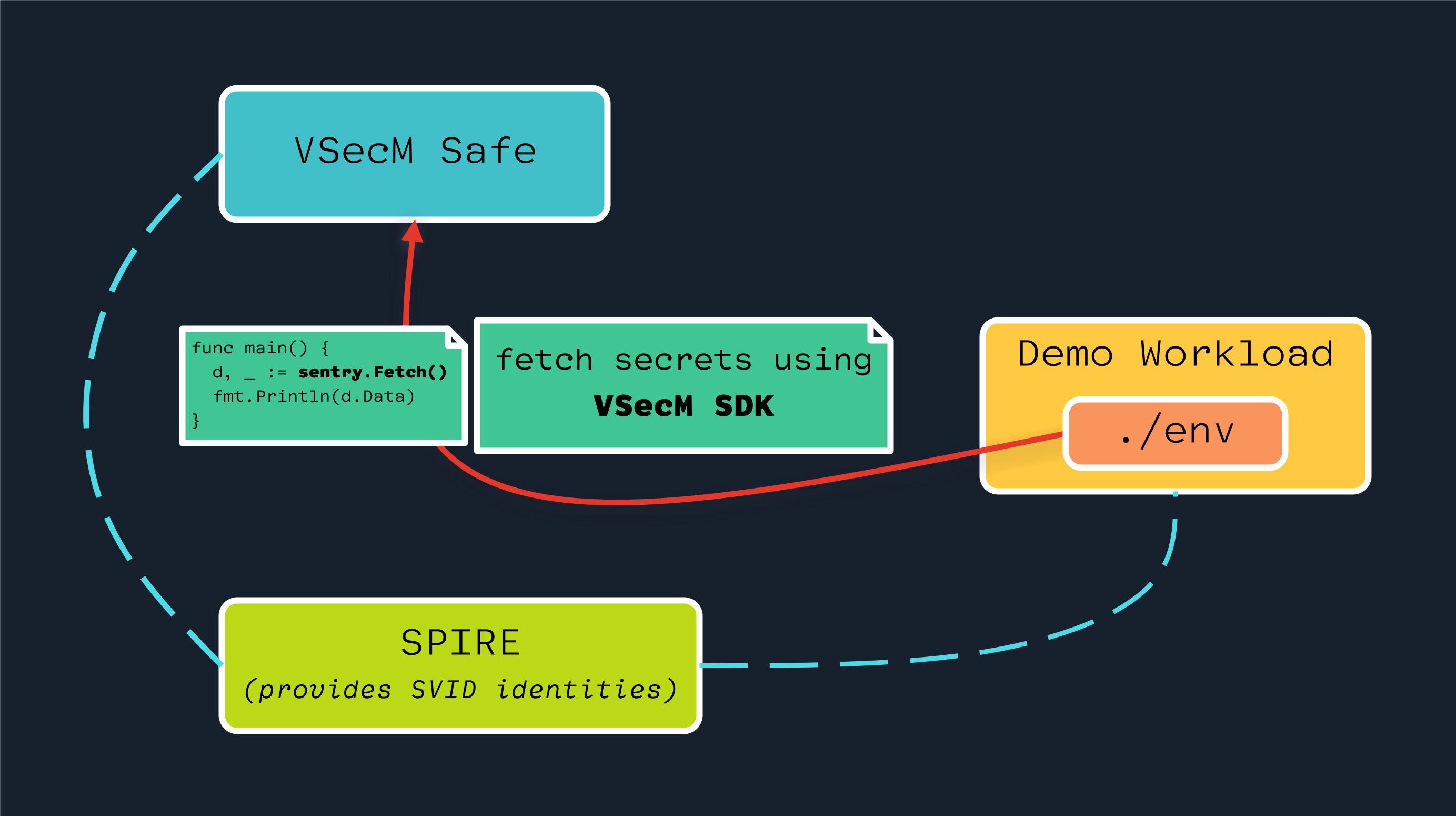
 Creating Secrets
Creating Secrets
VSecM Sentinel is the only place where secrets can be created and registered to VSecM Safe.
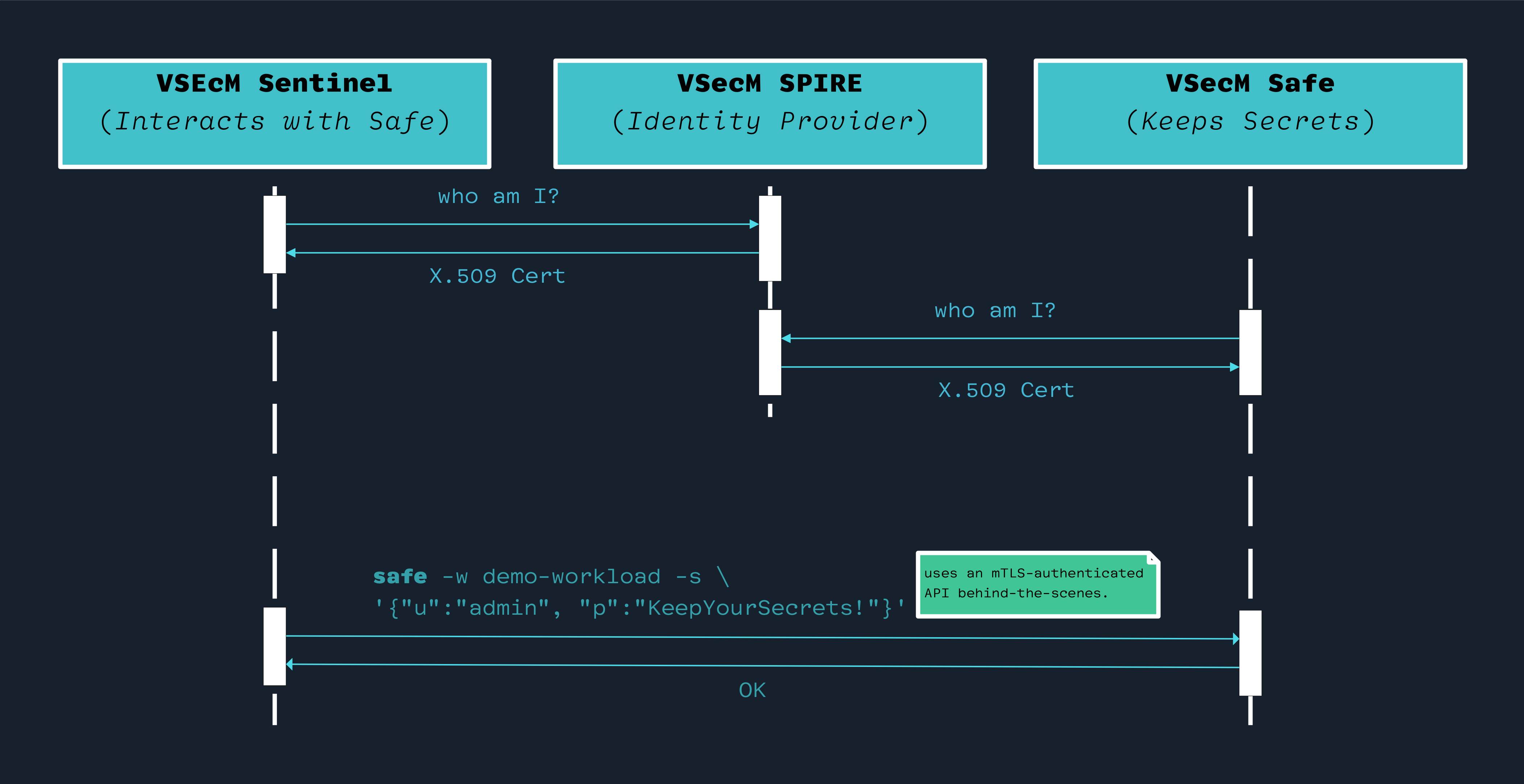
 Component and Workload SPIFFE ID Schemas
Component and Workload SPIFFE ID Schemas
SPIFFE ID format for workloads is as follows:
spiffe://vsecm.com/workload/$workloadName
/ns/{{ .PodMeta.Namespace }}
/sa/{{ .PodSpec.ServiceAccountName }}
/n/{{ .PodMeta.Name }}
For the non-vsecm-system workloads that Safe injects secrets,
$workloadName is determined by the workload’s ClusterSPIFFEID CRD.
For vsecm-system components, we use vsecm-safe and vsecm-sentinel
for the $workloadName (along with other attestors such as attesting
the service account and namespace):
spiffe://vsecm.com/workload/vsecm-safe
/ns/{{ .PodMeta.Namespace }}
/sa/{{ .PodSpec.ServiceAccountName }}
/n/{{ .PodMeta.Name }}
spiffe://vsecm.com/workload/vsecm-sentinel
/ns/{{ .PodMeta.Namespace }}
/sa/{{ .PodSpec.ServiceAccountName }}
/n/{{ .PodMeta.Name }}
You Can Have Custom SPIFFE ID Formats
You can configure your VSecM installation to use custom SPIFFE ID formats and RegExp-based validation rules. Check out the Configuration section for more details.
 A Note on SPIRE Controller Manager and ClusterSPIFFEIDs
A Note on SPIRE Controller Manager and ClusterSPIFFEIDs
VSecM uses SPIRE to establish an Identity Control Plane. And SPIRE uses SPIRE Controller Manager to manage the SPIRE Server and SPIRE Agent. SPIRE Controller Manager uses ClusterSPIFFEIDs to assign and determine SVIDs for workloads.
What this means for VSecM is that to assign identities to your workloads, you need to create ClusterSPIFFEIDs for them.
Here is an example:
apiVersion: spire.spiffe.io/v1alpha1
kind: ClusterSPIFFEID
metadata:
name: example-workload
spec:
className: "vsecm"
spiffeIDTemplate: "spiffe://vsecm.com\
/workload/example\
/ns/default\
/sa/example\
/n/{{ .PodMeta.Name }}"
podSelector:
matchLabels:
app.kubernetes.io/name: example-workload
workloadSelectorTemplates:
- "k8s:ns:default"
- "k8s:sa:example-workload-sa"
This ClusterSPIFFEID will assign the following SPIFFE ID to the workloads
that are in the default namespace, have the
app.kubernetes.io/name: example-workloadlabel, and use
the example-workload-sa service account.
Unless you are using a custom configuration for VSecM ClusterSPIFFEIDs,
the className field should be set to vsecm and the spiifeIDTemplate
should start wih spiffe://vsecm.com/workload/ followed by the name you give
to the workload.
You can check out the VSecM quick start guide for more information on how to create ClusterSPIFFEIDs for your workloads.
One additional thing to note about SPIRE Controller Manager is that it takes ownership of all SPIRE entries by default. This means that if you manually create an entry using SPIRE Server’s CLI, SPIRE Controller Manager will override it and reflect its own state that are defined in the ClusterSPIFFEIDs.
This essentially means that the ClusterSPIFFEIDs are the source of truth for identities in SPIRE and therefore in VSecM.
Can I Have My Own SPIRE Server Entries?
If you want to register your own SPIRE Server entries, you will need a custom SPIRE deployment that does not use SPIRE Controller Manager.
VMware Secrets Manager can work with any SPIFFE-compatible Identity Control Plane, so you can use your own SPIRE deployment if you want to.
However, using
ClusterSPIFFEIDs is the recommended way to assign identities to your workloads in VSecM. They are easier to manage and maintain because they are Kubernetes CRDs and use the declarative nature of Kubernetes.
 Persisting Secrets
Persisting Secrets
VSecM Safe uses age encryption by default to securely persist the
secrets to disk so that when its Pod is replaced by another Pod for any reason
(eviction, crash, system restart, etc.) it can retrieve secrets from a
persistent storage.
You Can Swap the Encryption Mechanism
In FIPS-compliant environments, you can use VMware Secrets Manager FIPS-compliant container images that use AES-256-GCM encryption instead of Age.
Check out the Configuration section for more details.
Also, you can opt out from auto-generating the private and public keys and provide your own keys. However, when you do this, you will have to manually unlock VSecM Safe by providing your keys every time it crashes. If you let VSecM Safe auto-generate the keys, you won’t have to do this; so you can
#sleepmore.Again, check out the Configuration section for more details.
Since decryption is relatively expensive, once a secret is retrieved, it is kept in memory and served from memory for better performance. Unfortunately, this also means the amount of secrets you have for all your workloads has to fit in the memory you allocate to VSecM Safe.
 Bootstrapping Flow of VSecM Safe
Bootstrapping Flow of VSecM Safe
To persist secrets, VSecM Safe needs a way to generate and securely store
the initial cryptographic keys that are utilized for decrypting and encrypting
the secrets, respectively. After generation, the keys are stored in a Kubernetes
Secret that only VSecM Safe can access.
Here is a sequence diagram of the VSecM Safe bootstrapping flow:
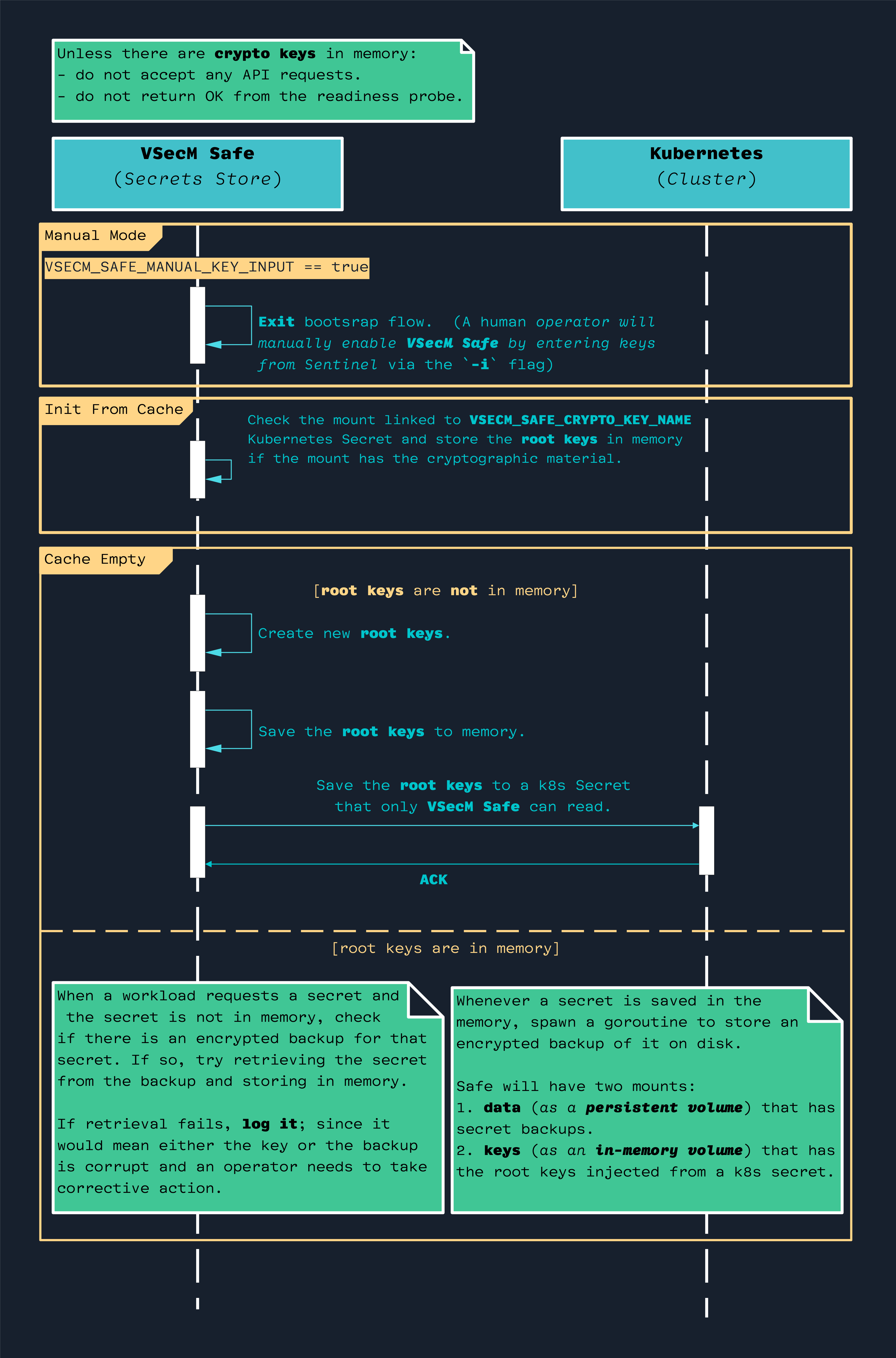
Note that, until bootstrapping is complete, VSecM Safe will not respond to any API requests that you make from VSecM Sentinel.
Here is a simplified version of the bootstrapping flow without taking the “manual key input” option into account:
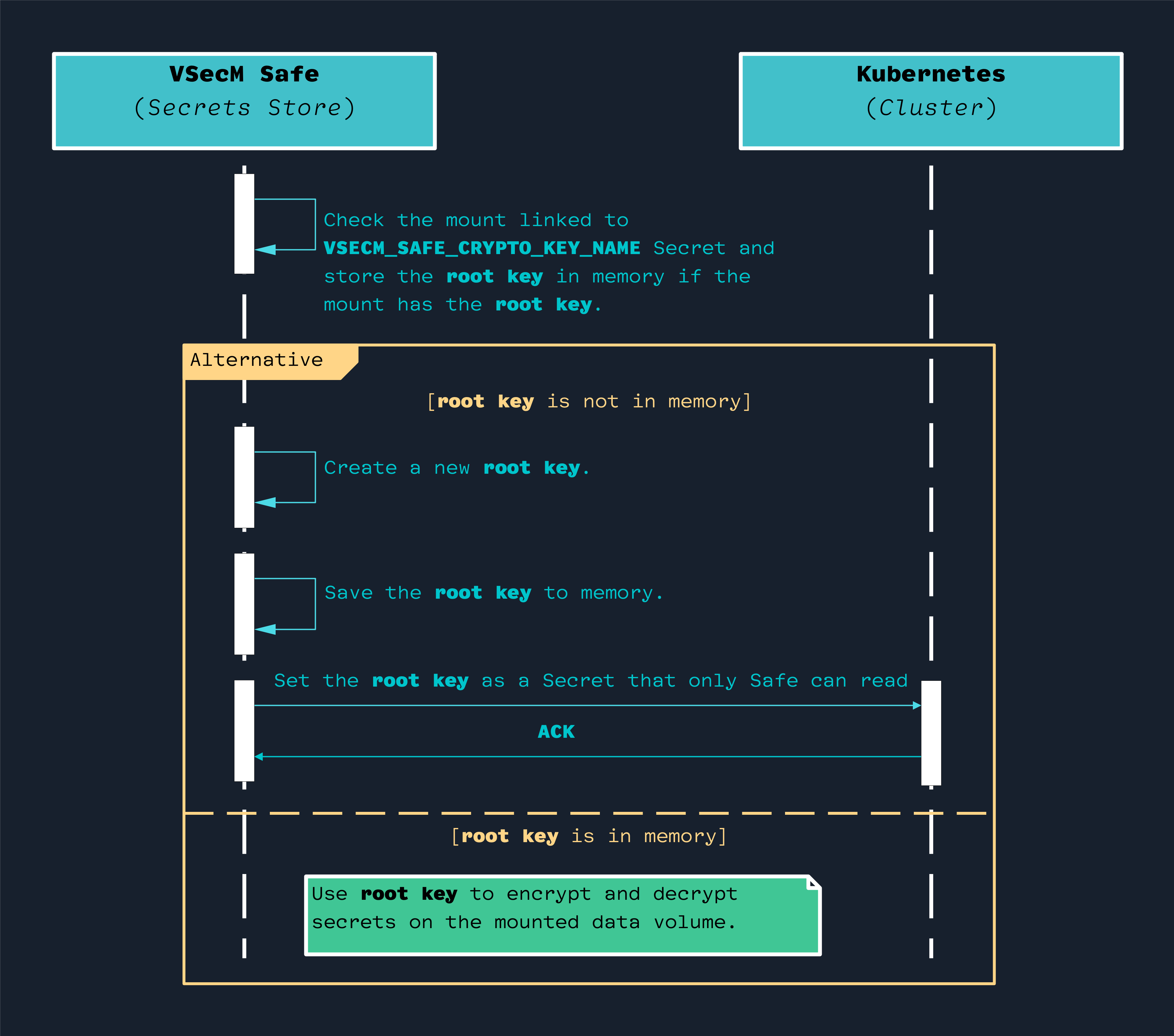
 VSecM Safe Pod Layout
VSecM Safe Pod Layout
Here is what an VSecM Safe Pod looks like at a high level:
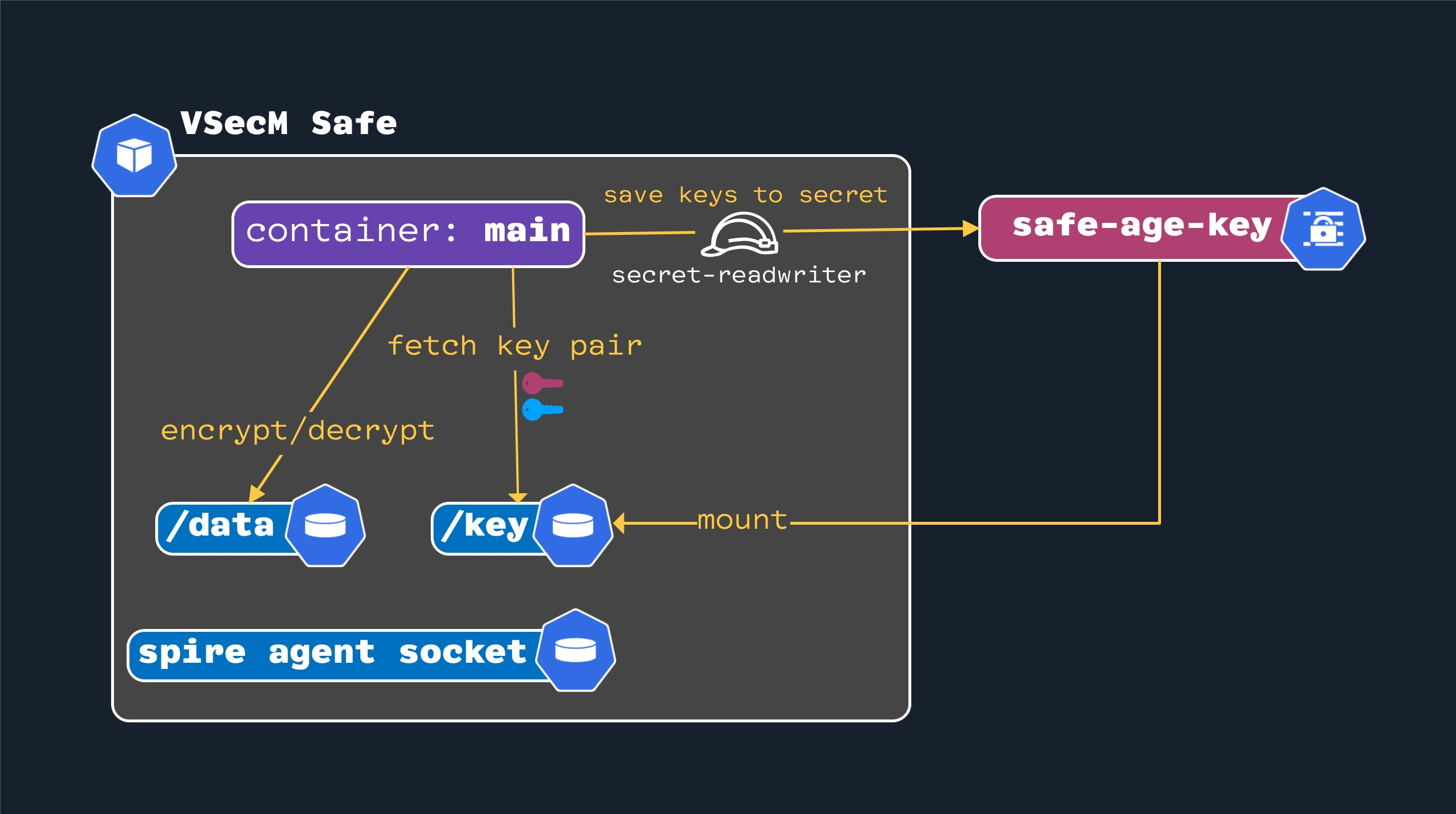
spire-agent-socket: Is a SPIFFE CSI Driver-managed volume that enables SPIRE to distribute X.509 SVIDs to the Pod./datais the volume where secrets are stored in an encrypted format. You are strongly encouraged to use a persistent volume for production setups to retrieve the secrets if the Pod crashes and restarts./keyis where the secretvsecm-root-keymounts. For security reasons, ensure that only the pod VSecM Safe can read and write tovsecm-root-keyand no one else has access. In this diagram, this is achieved by assigning avsecm-secret-readwriterrole to VSecM Safe and using that role to update the secret. Any pod that does not have the role will be unable to read or write to this secret.
If the main container does not have a public/private key pair in memory, it
will attempt to retrieve it from the /key volume. If that fails, it will
generate a brand new key pair and then store it in the vsecm-root-key secret.
 Template Transformation and Kubernetes Secret Generation
Template Transformation and Kubernetes Secret Generation
VSecM enables you to transform the secrets you register with VSecM Safe using Go template transformations before storing them. This is useful when you want to store a secret in a format that is different from the format you want to use in your workloads.
You can also prefix k8s: to the name of the workload to create a Kubernetes
Secret object with the transformed secret. This is useful when you want to
inject the secret to a workload using a Kubernetes Secret object instead
of VSecM Sidecar or VSecM SDK.
Check out the examples folder for examples of how to use
VSecM to transform secrets and generate Kubernetes Secret objects.
 Liveness and Readiness Probes
Liveness and Readiness Probes
VSecM Safe and VSecM Sentinel use liveness and readiness probes.
These probes are tiny web servers that serve at ports 8081 and 8082 by
default, respectively.
You can set VSECM_PROBE_LIVENESS_PORT (default :8081) and
VSECM_PROBE_READINESS_PORT (default :8082) environment variables to change
the ports used for these probes.
When the service is healthy, the liveness probe will return an HTTP 200 success
response. When the service is ready to receive traffic, the readiness
probe will return an HTTP 200 success response.
 Conclusion
Conclusion
This was a deeper overview of VMware Secrets Manager architecture. If you have further questions, feel free to join the VMware Secrets Manager community on Slack and ask them out.